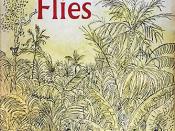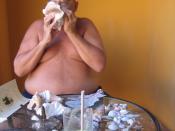William Golding's "Lord of the Flies" is a parable novel that demonstrates human nature at its most primal level. Lord of the Flies tells the story of a group of British schoolboys stranded on an island as a result of an airplane crash. Because of the absence of civilization, the boys ultimately resort to barbarism. Golding communicates his belief that man's nature is evil; without the restraints of society, humans will revert to their inner savagery. Golding uses symbolism in Lord of the Flies to develop his theme of evil in the human heart. He uses the conch shell, Piggy's glasses, and the sows head to develop this theme.
The conch shell is the first symbol Golding uses to develop his theme of evil in man's heart. At the beginning of the novel, the conch shell serves as a symbol of authority and a means of establishing order. After discovering a cream colored shell on the beach, Ralph blows in it to summon the other boys so they can "have a meeting" (16).
After the scattered boys appear, they establish a makeshift system of order and elect Ralph as their "chief" (22). Because Ralph holds the shell, Oldsey and Weintrab believe his role "turns responsible as leadership is thrust upon him" (20). As chief over the island, Ralph makes the rule that if someone holds the conch during an assembly, he is guaranteed the right to speak freely and uninterrupted (33). Fleck suggests that because Ralph possesses the conch, it represents "order" and "fair speech" (32). The boys use the conch shell as an orderly and fair means of communication.
After the conch loses its influence over the boys, it eventually breaks (181). Some of them begin to prefer a more savage and unruly way of life. Jack sets off...


